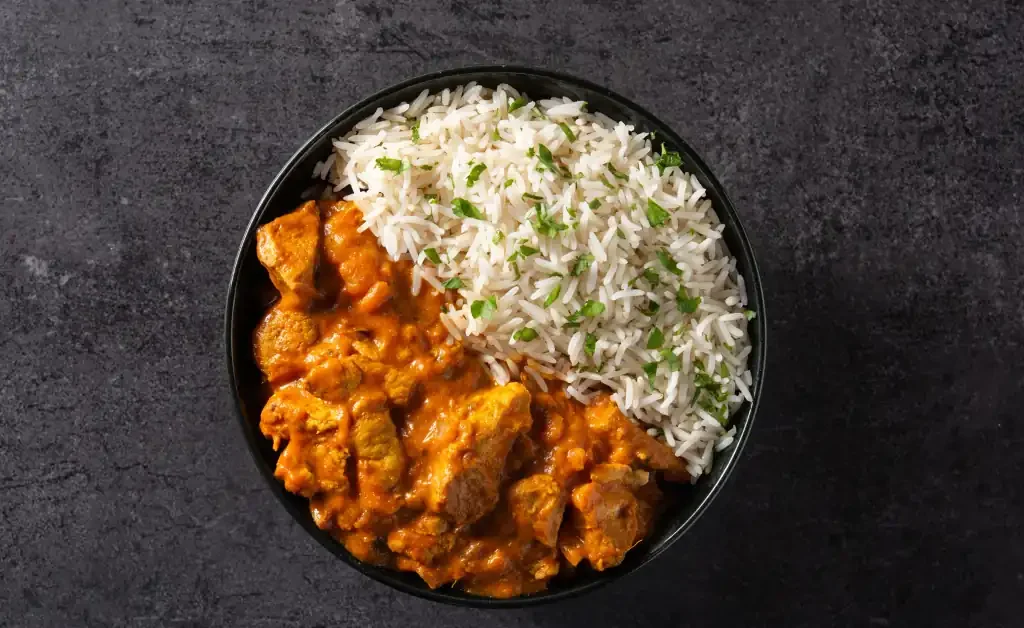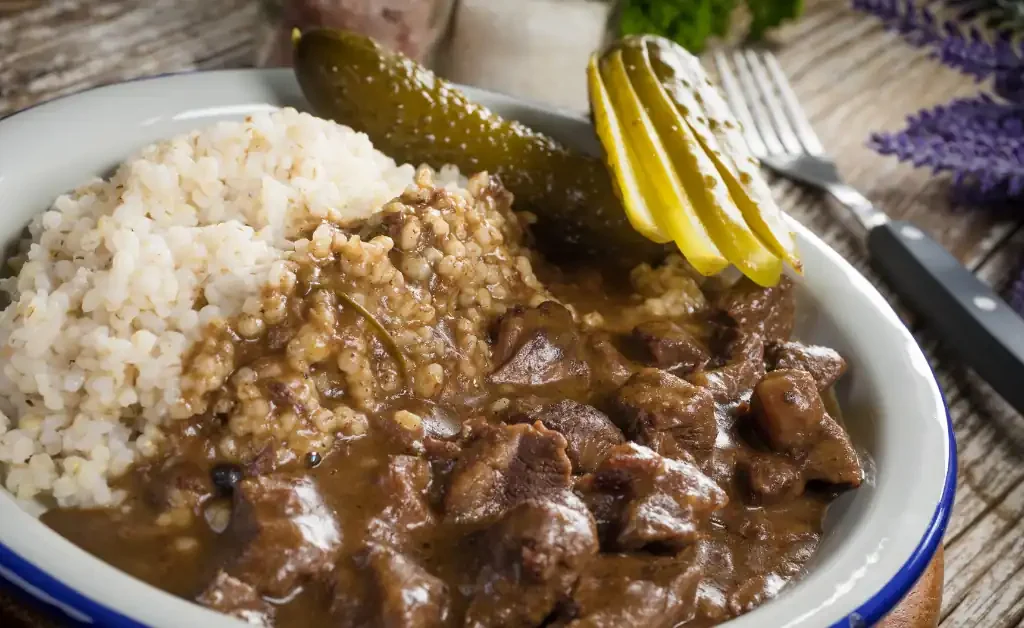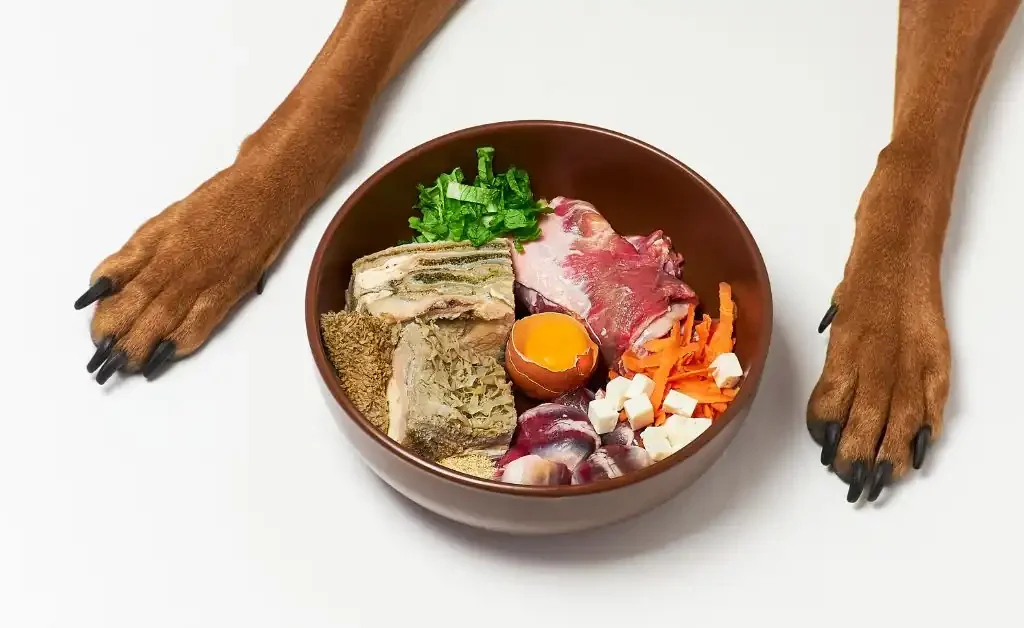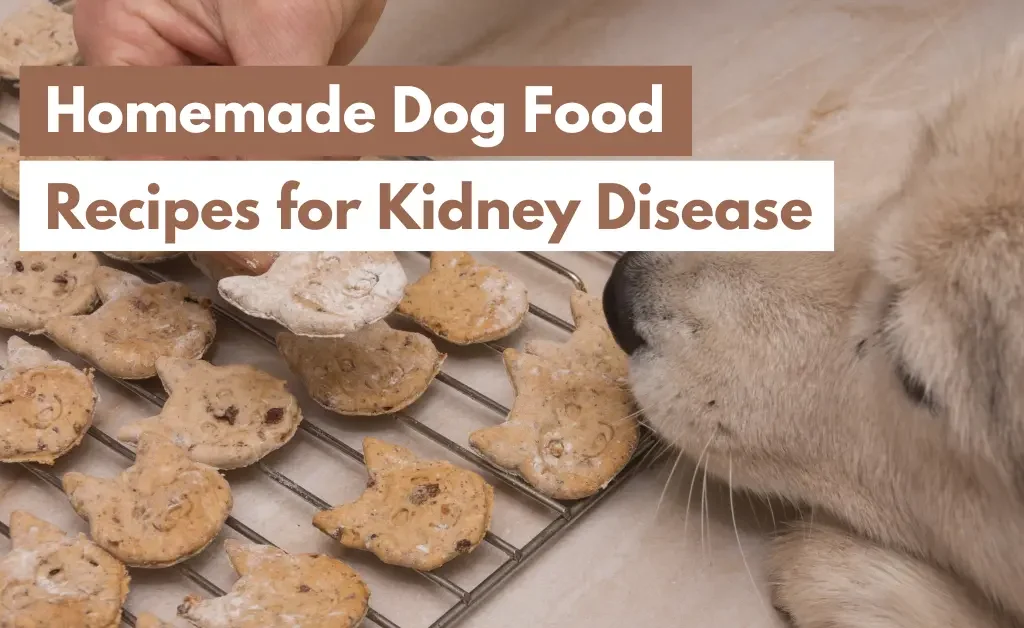People use homemade dog food when their beloved pet is diagnosed with a renal illness, which becomes critical to their health and quality of life. While commercial dog diets for kidney disease are available, many pet owners prefer homemade dog food for greater control over ingredients and a more personalized approach to their pet’s dietary needs.
Have the vets approved homemade dog food recipes for kidney disease? Homemade dog food for renal illness can provide various advantages, including superb ingredient quality, adaptation to individual needs, and possibly halting the condition’s progression.
In this blog, we’ve discussed the fundamentals of making homemade dog food for renal disease, ensuring that your canine companion gets the nutrition they require while enjoying meals tailored to their health condition. You will find much more below.
Kidney Failure in Dogs | A Quick Look!
Before we go ahead, let’s first look at what exactly this problem is, its causes, and symptoms. Well, kidney failure and renal failure are the same thing. It is caused by various diseases that affect a dog’s kidney and other related organs. Simply put, kidney failure happens when the kidney fails to perform its function properly.
Kidney failure disease is divided into two categories in dogs: acute renal failure and chronic renal failure. In case of acute renal failure, the performance of a dog’s kidney reduces suddenly with days or hours. It is often related to infections or toxins.
On the other hand, if the kidney’s performance reduces gradually over years, months, or weeks, it is commonly known as chronic renal failure. The major cause of this type of kidney failure is old age degeneration.
Early treatment can reverse acute renal failure, whereas you can only manage chronic renal failure (it is irreversible).
Potential Causes
- Toxicosis
- Dental disease
- Congenital disease
- Bacterial infections
- Geriatric degeneration
Prominent Symptoms You Should Be Familiar With
- Vomiting
- Mouth ulcers
- Pale gums
- Weight loss
- Blood in urine
- Increasing or decreasing water intake
4 Best Homemade Dog Food Recipes to Treat Kidney Disease in 2024
Certainly! Here are three homemade dog food kidney disease recipes that can benefit dogs with this disease:
1. Chicken with Rice
Ingredients
- 1 cup cooked skinless, boneless chicken
- 1 cup white rice, cooked
- 1/4 cup sweet potatoes, boiled and mashed
- 1/4 cup carrots, boiled and mashed
- 1/4 cup finely chopped cooked green beans
- 1 tablespoon extra virgin olive oil
- 1/2 teaspoon calcium carbonate (see your veterinarian for the correct dosage)
- For uniformity, use water.

How to Prepare?
- Cook chicken appropriately, removing bones, skin, and extra fat. Make bite-sized chicken chunks.
- Prepare the white rice following the directions on the package, then cool. In a mixing dish, combine chicken, rice, mashed sweet potatoes, carrots, finely chopped green beans, olive oil, and calcium carbonate. Mix thoroughly.
- Make sure the mixture is neither too dry nor too watery as you progressively add water to get the proper consistency.
- Depending on your dog’s demands, serve the homemade dog food in the right portion proportions. Keep remains for up to three days in the refrigerator.
This dish offers a good combination of veggies, lean protein, and simple carbohydrates. The extra olive oil provides healthy fats. According to your dog’s size, adjust the component amounts. For specialized nutritional advice, speak with your veterinarian.
2. Beef and Barley Stew
Ingredients
- 1 cup of lean beef
- 1/fourth cup boiled barley
- a quarter cup of mashed, cooked butternut squash
- a quarter cup of cooked and sliced courgette
- Green peas, boiled and diced, 14 cups
- Canola oil, 1 tablespoon
- Calcium carbonate, half a teaspoon
- For uniformity, use water

How to Prepare?
- Cook the ground beef in a skillet until browned. Remove any extra fat. After cooking the barley per the package directions, let it cool.
- Mix ground beef, barley, mashed butternut squash, chopped zucchini, chopped green peas, canola oil, and calcium carbonate in a mixing dish.
- To reach the correct consistency, gradually add water.
- Serve the homemade dog food in reasonable serving quantities and store any leftovers in the refrigerator for up to three days.
3. Sweet Potato and Fish Delight
Ingredients
- 1 cup cooked fish, such as salmon, tilapia, or cod
- a half-cup of mashed, cooked sweet potatoes
- a quarter cup of cooked, chopped green beans
- boiled, finely chopped 1/4 cup spinach
- 1 tsp. fish oil, which is high in omega-3 fatty acids
- For uniformity, use water

Instructions
- Ensure there are no bones in the fish, and thoroughly cook it. Fish should be broken into small pieces. Mash the cooked sweet potatoes after they are fully cooked.
- Fish oil, cooked fish, mashed sweet potatoes, finely chopped spinach, and green beans are combined in a mixing bowl.
- For the desired consistency, gradually add water.
- Serve the homemade dog food in reasonable serving quantities and store leftovers in airtight containers in the refrigerator for up to three days.
Fish, often lower in phosphorus than other meat sources, supplies lean protein in this recipe. Green beans and spinach provide essential nutrients, while sweet potatoes provide complex carbohydrates. For specialized nutritional advice, consult your vet and modify the components to your dog’s size.
4. Pork and High-Fat Food
Ingredients
- 8 tablespoon oil
- 74g pork
- 6.7g omega-3 pet liquid
- 3.3g wholistic pet organics
- 0.38g Morton iodized salt

How to Prepare?
- Take a large bowl and mix all ingredients in it until they are mixed well.
- Make the appropriate serving size by dividing the mixture.
Now, serve each serving to your dog at either slightly warmed or room temperature.
You may aslo like reading through:
5 Perks of Giving Your Furry Friend Homemade Dog Foods
Feeding homemade dog food has several noticeable advantages for dogs with kidney illnesses. These advantages consist of the following:
1. Quality Control
You have control over the ingredients used while making homemade dog food. Choose the best-quality protein sources, such as lean meats like chicken or turkey, to lessen the kidney strain while guaranteeing appropriate nutrition. Additionally, you can keep your dog’s kidneys healthy by avoiding the chemicals, preservatives, and high sodium content sometimes found in commercial dog diets.
2. Improved Palatability
Dogs with renal illness may have decreased appetite or dietary restrictions. Homemade dog food allows you to produce delectable meals according to your dog’s taste preferences, encouraging them to eat and stay healthy. Including various ingredients can also provide extra sensory stimulation, making mealtime more delightful for your pet.
3. Toxin Exposure is Reduced
Some commercial dog diets may include toxins or pollutants that put additional pressure on the kidneys. When you self-prepare your meals, you have more control over the origin and quality of the components, lowering your risk of exposure to potentially dangerous compounds. This can improve your dog’s renal function and overall well-being.
4. Customization
Depending on the stage of renal disease and other health considerations, each dog’s dietary requirements may vary. Homemade food allows you to adjust the diet to your pet’s needs. Protein, phosphorus, and sodium levels can be adjusted to meet your veterinarian’s recommendations. This personalized approach can aid in illness management and your dog’s overall health.
5. Enhanced Nutrient Absorption
Dogs suffering from kidney illness may have trouble absorbing nutrients from their food. Homemade dog food allows for the use of easily digested foods, allowing your dog’s body to absorb essential nutrients more quickly. This can help prevent malnutrition and improve your pet’s general health.
While homemade dog food for renal illness has various advantages, contacting a veterinarian or veterinary nutritionist is essential to satisfy your dog’s dietary needs. They may advise you on clear component choices, portion sizes, and any supplements required to produce a balanced diet for your pet.
History of Using Homemade Food for Dogs with Kidney Disease
Since it is a relatively new development, homemade dog food has become increasingly well-liked among pet owners looking for alternate dietary options for their animals. While no historical information is related explicitly to homemade dog food kidney disease, the customizing of meals for animals with medical issues has long been practiced.
Veterinarians previously primarily used commercial dog diets designed for canines with kidney problems. By lessening the strain on the kidneys and preserving the proper nutrient balance, these specialized diets were created to manage the illness. However, some pet owners started to voice concerns about the ingredients and quality of commercial dog diets, which sparked an interest in homemade substitutes.
The idea of making your dog food came about as a method to have more control over the ingredients and cater to specific dietary requirements as pet nutrition research developed and pet owners got more invested in the health of their animals. This method enables customization depending on the particular needs of canines with kidney disease, taking into account elements such as the illness stage, the results of blood tests, and general health.
Dog Owners’ Opinions
Anecdotal evidence and positive results reported by pet owners who chose homemade dog food for renal disease started to accumulate over time. Many people noted improvements in their dogs’ appetite, ability to maintain weight, and general health. These endorsements have helped homemade dog food gain acceptability and popularity as a sensible option for treating canine renal illness, as has the expansion of trustworthy information on pet nutrition.
Homemade food for dogs with kidney disease must be used cautiously and under a veterinarian or veterinary nutritionist’s advice, although it can have advantages. A professional’s knowledge is required to ensure that homemade meals cover all the unique nutritional needs while reducing any dangers or consequences. Kidney illness in dogs needs a delicate balance of nutrients.
The usage of homemade dog food for kidney disease is expected to change over time, with improved recipes and more specialized methods as research advances and more data becomes accessible. The benefits and limitations of homemade dog food as a therapeutic alternative for canine renal illness will be better understood with continued cooperation between pet owners, veterinarians, and veterinary nutritionists.
What Do Vets Say About Using Homemade Dog Food for Kidney Disease Treatment?
Some vet approved homemade dog food recipes for kidney disease. While some vets might favor the notion and offer precise instructions or recipes, others might be wary or hesitant. Before making any dietary modifications, speaking with a veterinarian or veterinary nutritionist with experience in treating canine renal illness is crucial.
Concerning homemade dog food for kidney disease, veterinarians frequently bring up the following issues:
1. Nutritional Balance
Providing dogs with kidney illness with nutritionally balanced food is essential. Commercial diets for kidney illness undergo extensive testing to meet particular dietary needs. On the other hand, homemade diets need careful planning and supervision to guarantee they contain the right proportions of protein, phosphorus, salt, and other necessary nutrients.
2. Individualized Approach
The severity and course of kidney disease can differ from dog to dog. Veterinarians may contend that commercially produced diets offer a standardized strategy that is simpler to apply in various situations. However, homemade food for dogs with kidney disease can be tailored to meet particular needs, considering elements like the dog’s overall health, the blood test results, and the stage of renal illness.
3. Potential dangers
If homemade diets are not appropriately prepared, they may be fine. While high phosphorus or sodium intake might deteriorate renal function, insufficient protein intake can cause muscle atrophy. Additionally, homemade diets could be deficient in several elements for good health. Any potential nutritional imbalances or deficiencies can be addressed with regular bloodwork monitoring and consultation with a veterinarian.
4. Time and Effort
Making homemade dog food takes dedication, time, and effort. It entails obtaining high-quality ingredients, cooking food correctly, and monitoring and making necessary adjustments. Long-term consistency and ensuring the diet’s nutritional sufficiency may require more work for sure pet owners.
Remember that every dog has a different situation, so what’s suitable for one dog might not work for another. Always seek advice from a vet or veterinary nutritionist who is educated about kidney illness and skilled at creating customized diets. They may offer insightful advice, assist in developing wholesome meals, and keep track of the dog’s development to ensure the food successfully promotes kidney health.
What Food Items Should You Avoid Giving a Dog with Kidney Disease?
Well, food is not the only reason behind kidney failure; instead, it happens due to a couple of reasons like underlying health conditions, toxins, genetic factors, and more. However, you should not give rawhide, jerky, red meat, and pig’s ears to your canine, as they contain high phosphorus levels, high salt, or high protein.
Why Might Making Homemade Dog Food Not Be the Right Option for You?
We understand you have opened this guide to explore the facts associated with making and giving your canine homemade dog food recipes for kidney disease. But there can be a couple of challenges (as listed below) you must be familiar with.
- Preparing homemade food for your dog daily or weekly is indeed a time-consuming job.
- High-quality ingredients are costly compared to the premium dog food available at leading dog care stores.
- Maintaining consistency in the diet becomes the biggest challenge.
- Regular vet consultations are required to maintain nutritional balance, which is again a tough nut to crack.
In my opinion, it is always better to find a trusted online or on-site dog care store and buy premium food packets for kidney disease.
Last Note
Why has the vet approved homemade dog food recipes for kidney disease? What is the reason behind this? Is it actually beneficial for renal treatment in dogs? Yes, it is worth it in some cases. We have a deep discussion and a few recipes that may help you. If you missed them, scroll up and read thoroughly to have a better understanding.
Frequently Asked Questions (FAQs)
Q: Have vet-approved homemade dog food recipes for kidney disease as well as CVDs?
A: The vet has not approved any homemade treatment for cardiovascular disease in dogs. However, he has approved such foods for renal illness. CVDs are a more severe and typical health concern that must not be entertained at home without a veterinarian guide.
Q: Can I give homemade sausages to my dog with kidney disease?
A: It is good to ask your veterinarian before adding sausages to your dog’s diet with underlying renal illness. Take as many precautionary steps as you can to save your pet’s health.
Q: Can I increase the amount of milk I feed my dog with kidney disease?
A: Milk is not a welcoming diet for every dog. Some are lactose intolerant and can show severe reactions when fed with milk, especially with kidney disease. Always consult a specialist before adding milk or any other supplement to your dog’s daily food.




